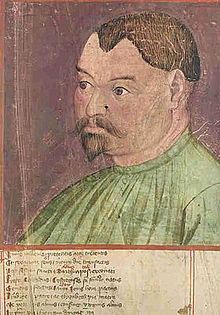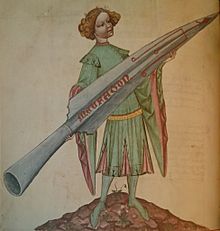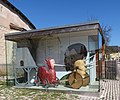Bellifortis

Bellifortis ( Latin for the strong man ) is a fully illustrated military technical manual by Konrad Kyeser from Eichstatt . It was written in Latin until 1402 (the oldest edition) and was widely used geographically in the course of the 15th and early 16th centuries in more or less different versions. A distinction is made between an original version with 10 chapters, which was soon reworked into a version with 7 chapters. In other later manuscripts the material was shortened, added to with other texts, rearranged and also translated, so that a whole family of branching types results. Today the work has survived in around 45 manuscripts from the 15th and early 16th centuries. It was not put into a print version.
History of the work
Konrad Kyeser wrote the work before 1402 at the court of King Wenceslas in Prague after the 1394 crusades of King Sigismund of Hungary against the Ottomans took part, he Sigismund blamed for its failure in his Bellifortis. He has probably also been to Italy, especially Padua , where he was able to get to know a new culture of illustrated non-fiction books that referred to individual ancient models. The oldest known copy from 1402 is now kept in Göttingen (Göttingen 4 ° Cod. Ms. philos. 64a). Around 1405 he produced another richly illustrated manuscript with painters from the royal court in the vicinity of the so-called Wenceslas workshop (Göttingen 2 ° Cod. Ms. philos. 63).
The initial structure in 10 chapters was revised around 1410 in favor of a version with 7 chapters (preserved as the oldest copies in the manuscripts Rome Cod. Pal. Lat. 1994 and Chantilly Ms. 348). This version was continued mainly in Alsace in Strasbourg and Hagenau . After Kyeser's death, a new 7-chapter version with a different sequence was probably created on the Upper Rhine or in Swabia around 1425. At an early stage, the material was supplemented with other texts and the work was geared more towards practical use by gunsmiths and members of the military.
content
The Bellifortis summarizes, in the form of a manual, machines and devices, especially for war purposes, which the author was familiar with from ancient texts or his own experience. Works such as Vegetius' De Re Militari from the 5th century or the strategemata of Sextus Iulius Frontinus from the 1st century are regarded as forerunners of Bellifortis .
The Bellifortis offers a sequence of individual topics of warfare that Keyser had adopted as a structure from ancient literature: the field battle, the siege war, the defensive war and the sea war. In a first version with the 10 chapters this resulted in the following sequence: (1) field battle, (2) siege, (3) water technology, (4) climbing gear, (5) mechanical firearms, (6) defense, (7) flares, ( 8) pyrotechnics, (9) thermal engineering and (10) natural weapons and various supplements. Before his death, Kyeser himself worked out a version with seven chapters.
The devices described are technically not always correctly reproduced. In the case of devices that Kyeser was familiar with from personal experience, however, the representations sometimes achieve an extraordinary wealth of detail. Some of the devices are shown for the first time in Kyeser's handwriting. This includes the first clear medieval illustration of an Archimedean screw and the oldest known drawing of a chastity belt . In part, he describes impractical suggestions or depicts apparently fantastic devices that can be assigned to the realm of utopia . In accordance with the humanistic understanding of natural science in the late Middle Ages , with which Kyeser was familiar as a doctor, he also included alchemical and astrological topics in his Bellifortis. In particular, Kyeser used astrological image content such as planetary images of Sol , Mars , Jupiter or Venus , or allegorical depictions of the four elements fire , water , air and earth to underline the universality of his work.
Kyeser shows a special admiration for Alexander the Great in his Bellifortis , to whom fabulous powers are ascribed in the Bellifortis editions and which is often depicted on horseback or with a rocket-like object with the obscure inscription MEUFATON or MAUFAGON .
The explanation lies in medieval mythology. A squire carries the victorious spearhead "Meufaton" of the flag lance "Almerio" of Alexander the Great . Alexander threw the lance in 334 BC. On Asia before he set foot on Asia. This throw is interpreted as a sign of victory. In addition, the spearhead is painted with brown characters. The signs should be painted on the palms of the soldiers, presumably to strengthen their confidence in victory through the symbolism / mysticism and thus strengthen their fighting strength.
meaning
Konrad Kyeser's Bellifortis is considered to be the earliest technical encyclopedia in the German-speaking world.
Initially, the sophisticated Latin work was intended for a royal court and court society. References to the handicraft and the consideration of the applicability initially and also in many later copies hardly played a role. At first, Kyeser also made changes himself.
It was only later, from around 1430, that the work came into circulation with the corresponding engineers and gunsmiths, especially in German-speaking countries, and was distributed in several different editorial offices and compiled with different manuscripts , including in the manufacturing business . In the meantime, 45 surviving manuscripts are known, which sometimes differ greatly from Kyeser's first versions in terms of scope, text and images. The pressure in the 16th century came only individual images from the manuscripts. Kyeser's Bellifortis served as a template and inspiration for many subsequent authors; u. a. his ideas can also be found in Leonardo da Vinci's works. An autograph manuscript written by Kyeser's own hand in 1405 , which he dedicated to Ruprecht von der Pfalz , is now in the holdings of the Göttingen University Library .
Manuscripts (selection)
The assignment to the tradition follows the stemma of the manuscripts by Regina Cermann 2013
- Berlin, German Historical Museum - Library, RA 18/414 (formerly Berlin State Library - Prussian Cultural Heritage, Ms. germ. Quart. 2041)
- Berlin, State Library of Berlin - Prussian Cultural Heritage, Ms. germ. Quart. 621
- Besançon, Bibliothèque municipale, Ms. 1360 individual digital copies , around 1415, modified 7-chapter version
- Chantilly, Musée Condé, Ms. 348 (old 633), around 1410, early 7-chapter version
- Erlangen, University Library , Ms. B 26 digital copy , around 1500, by Ludwig von Eyb, made in Franconia
- Frankfurt a. M., University Library , Ms. germ. Qu. 15 (formerly city library, n.d., digitized version) around 1450/60, 7-chapter version (Kyeser), created in Hagenau in Alsace
- Göttingen, Lower Saxony State and University Library , 4 ° Cod. Ms. philos. 64a, 1402, 10-chapter version (autograph by Kyeser), created in Kuttenberg
- Göttingen, Lower Saxony State and University Library, 2 ° Cod. Ms. philos. 63, around 1405, 10-chapter version (autograph by Kyeser), probably made in Prague
- Göttingen, Lower Saxony State and University Library, 2 ° Cod. Ms. philos. 64, around 1430, modified 7-chapter version, originated in Swabia
- Heidelberg, Heidelberg University Library , Cod. Pal. germ. 787 ( digitized version), around 1430, modified 7-chapter version, made in Rhine Franconia
- Karlsruhe, Badische Landesbibliothek , Cod. Durlach 11 ( digitized version ), 15th century
- Cologne, Historical Archive of the City , Best. 7020 [W *] 232
- Munich, Bayerische Staatsbibliothek , Clm 30150 ( digitized version ), around 1430, possibly made in Bohemia
- Munich, Bavarian State Library, Cod.Hebr. 235
- Munich, Bavarian State Library, Cgm 356, end of the 15th century
- Munich, Bayerische Staatsbibliothek, Cgm 600 partially digitized in b / w , 1st quarter of the 15th century.
- New York, Public Library, Spencer Collection, Ms. 58 ( excerpts )
- New York, Public Library, Spencer Collection, Ms. 104 (formerly Hollwinkel Castle near Lübbecke), ( selection of individual pages ), approx. 1445, probably made in the Lake Constance area
- Nuremberg, Germanisches Nationalmuseum , Hs. 25.801
- Rome, Biblioteca Apostolica Vaticana , Cod. Pal. lat. 1994, around 1410, early 7-chapter version (oldest text witness for this version), presumably written in Strasbourg
- Rome, Biblioteca Apostolica Vaticana, Cod. Pal. lat. 1888, around 1430, changed 7-chapter version, probably originated in the Upper Palatinate
- Rome, Biblioteca Apostolica Vaticana, Cod. Pal. lat. 1889
- Rome, Biblioteca Apostolica Vaticana, Cod. Pal. lat. 1986
- Strasbourg, Bibliothèque Nationale et Universitaire, Ms. 2259
- Vienna, Austrian National Library , Cod. 3062, around 1435, extended / redesigned 7-chapter version (Hartlieb)
- Vienna, Austrian National Library, Cod. 3068
- Vienna, Austrian National Library, Cod. 3069
- Vienna, Austrian National Library, Cod. 5014
- Vienna, Austrian National Library, Cod. 5135
- Vienna, Austrian National Library, Cod. 5278, around 1420, 7-chapter version
- Vienna, Austrian National Library, Cod. 5518
- Wolfenbüttel, Herzog August Library, Cod. Guelf. 161 Blank.
Illustrations
Selection of images from various Bellifortis editions and replicas of devices
Replicas in the Altmühl center in Dollnstein
literature
- Regina Cermann: The 'Bellifortis' by Konrad Kyeser (= Codices Manuscripti & Impressi, Supplementum . No. 8 ). Hollinek, 2013, ISSN 0379-3621 .
- Rainer Leng: Konrad Kyeser, Bellifortis (including Hartlieb and Bellifortis arrangements) . In: Fireworks and War Books (= catalog of German-language illustrated manuscripts of the Middle Ages ). Publishing house of the Bavarian Academy of Sciences / CH Beck, Munich 2009, p. 203-504 .
- Rainer Leng : Ars belli. German tactical and war-technical illuminated manuscripts and treatises in the 15th and 16th centuries . tape 1 . Reichelt, Wiesbaden 2002, ISBN 978-3-89500-261-8 , pp. 109-149 .
- Kulturstiftung der Länder, Bayerische Staatsbibliothek (Ed.): Konrad Kyeser, Bellifortis: Clm 30150 / Bayerische Staatsbibliothek (= Kulturstiftung der Länder - Pairimonia 137 ). 2000, ISSN 0941-7036 .
- Regina Cermann: Astantes stolidos sic immutabo stultos - Of careless scribes and discerning illuminators. On the interplay of text and image in Konrad Kyeser's Bellifortis . In: Christine Beier, Evelyn Theresia Kubina (ed.): Paths to the illuminated book. Production conditions for book illumination in the Middle Ages and early modern times . Böhlau, Vienna 2014, ISBN 978-3-205-79491-2 , p. 148–176 ( online [PDF; accessed November 2, 2017]).
- Theresia Berg, Udo Friedrich: Strading knowledge in late medieval writings on the art of war: The "Bellifortis" of Konrad Kyeser and the anonymous "Fireworks Book" . In: Jan-Dirk Müller (Ed.): Knowledge for the farm. The late medieval writing process using the example of Heidelberg in the 15th century . Fink, Munich 1994, ISBN 3-7705-2880-8 , pp. 169-232 . ( Online version at the BSB Munich )
- Udo Friedrich: Ruler's duties and the art of war. For the intended use of early 'Bellifortis' manuscripts . In: H. Keller, Ch.Meier, D. Hüpper (eds.): The Codex in Use (= files of the 2nd International Colloquium of the SFB . No. 231 ). Fink, Munich 1996, p. 197–210 ( Digitale-sammlungen.de [accessed March 17, 2019]).
facsimile
- Hans Blosen, Rikke Agnete Olsen (Ed.): Art of war and cannons. The gunsmith's book by Johannes Bengedans . Aarhus University Press, Aarhus 2006, ISBN 978-87-7934-162-3 (facsimile volume with transcription and translation in Danish and German).
- Georg Agricola Society for the Promotion of the History of Natural Sciences and Technology (Ed.): Bellifortis . VDI-Verlag, Düsseldorf 1967 (facsimile volume and separate volume, transcription and translation by Götz Quarg).
Web links
- Kyeser, Konrad: Bellifortis in the Historical Lexicon of Bavaria
- Rainer Leng: Kyeser, Konrad: Bellifortis on: Historisches Lexikon Bayerns
- Description of the Göttingen manuscript
Individual evidence
- ^ A b Christoph Graf zu Waldenburg Wolfegg: The Munich> Bellifortis <and its author . In: Kulturstiftung der Länder, Bayerische Staatsbibliothek (ed.): Konrad Kyeser, Bellifortis: Clm 30150 / Bayerische Staatsbibliothek (= Kulturstiftung der Länder - Patrimonia 137 ). 2000, ISSN 0941-7036 , p. 21-54 .
- ↑ Regina Cermann: The 'Bellifortis' of Konrad Kyeser is fundamental, with the inclusion and critical appreciation of older research. Hollinek 2013.
- ↑ Leng 2002, Vol. 1, p. 114.
- ^ Wilfried Tittmann: The gun depictions of Walter de Milemète from 1326/7. New version supplemented by comments and illustrations with a supplement (as of 2011). In: ruhr-uni-bochum.de, Ruhr-Universität Bochum, version dated December 30, 2011, (cited analysis by Quarg 1967). PDF (2.7 MB), accessed on November 17, 2018.
- ^ Ernst Berninger: The technical manuscripts of the 15th century in the Bavarian State Library in Munich . In: Konrad Kyeser, Bellifortis: Clm 30150 / Bayerische Staatsbibliothek (= Kulturstiftung der Länder - Patrimonia 137 ). 2000, ISSN 0941-7036 , p. 61-87 .
- ↑ Regina Cermann: The, Bellifortis' of Konrad Kyeser. Hollinek 2013, pp. 94-95.







